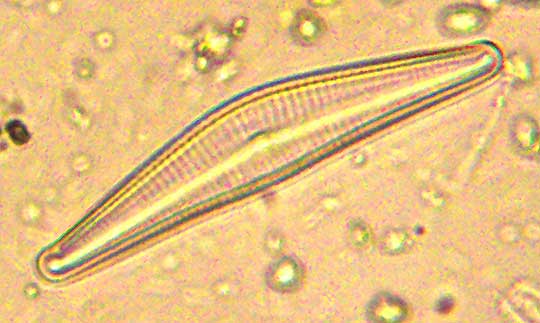Excerpts from Jim Conrad's
Naturalist Newsletter
from the January 6, 2013 Newsletter issued from the valley of the Dry Frio River in northern Uvalde County, southwestern Texas, on the southern border of the Edwards Plateau; elevation ~1750m (~5750 ft); N29.62°, W99.86°; USA
DIATOMS
Scanning a thin smear of mud from the little Dry Frio River behind the cabin, beneath the microscope I found lots of what's shown below:

Using the excellent, free-to-use " Pond Life Identification Kit" at Microscopy-UK.Org.UK I found that despite the organism in the picture not being green, it's an alga. On the Pond Life site's algae page, then it was easy enough to discover that our colorful little being is a diatom, which the page describes as "usually brownish, silica cell wall in two parts, solitary or colonial, some have a slow gliding motion, < 0.5 mm."
Browsing through various diatom pages I was reminded that diatoms are unicellular organisms who photosynthesize with yellow-brown chloroplasts instead of green ones. Diatom cell walls are made of silica so they're almost like glass houses -- silica being silicon dioxide, SiO2, and SiO2 being the formula for quartz and pure sand, from which glass is made. The diatom's cell wall, called a frustule, consists of two silica valves that fit into each other like little pill boxes. If you look closely, you can see this construction in our photograph.
Traditionally, diatoms have been divided into two main groups -- those with radial symmetry and those configured bilaterally, like ours. In freshwater environments the bilateral ones, often referred to as the pennate type, are the most commonly encountered.
The earliest diatom fossils are from about 100 million years ago. Over time, as incredible numbers of diatoms died in the oceans, their silica shells sank to the sea floor forming thick layers of mud. Because silica is hard and chemically stable in seawater, the shells were preserved, and eventually geological processes created thick deposits of diatomaceous earth, a sedimentary rock that can be crumbled into a white powder also called diatomaceous earth, which nowadays is used in many ways.
Powdered diatomaceous earth is used in filters, as a mild abrasive in products such as toothpaste, as an insecticide (When the insect cleans its legs, the sharp-edged shells enter the gut, cutting it to pieces like ground glass), to absorb liquids (used in cat litter), as a matting agent for paint coatings, to reinforce plastics and rubber, to stabilize dynamite, as a thermal insulator, and much more. Under the microscope diatomaceous earth shows diatom skeletons and parts of skeletons, some of which are similar to our Dry Frio one.
Even having learned all this long ago, until now I've been unclear as to whether diatoms could be found someplace like the little Dry Frio River behind the cabin.
Now we know that they can be, and that they are abundant. In fact, there are more than 200 genera of living diatoms, in which about 100,000 surviving species are recognized, and those species occupy habitats ranging from the open ocean to freshwater and beyond, including soils and a huge variety of generally damp surfaces.
Using the [at one time] freely available "Diatoms of the United States" resource I find that possibly our diatom is an "asymmetrical biraphid," but I can't say which one.